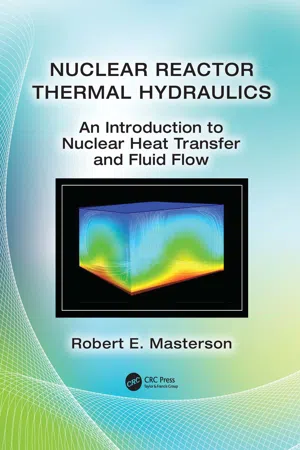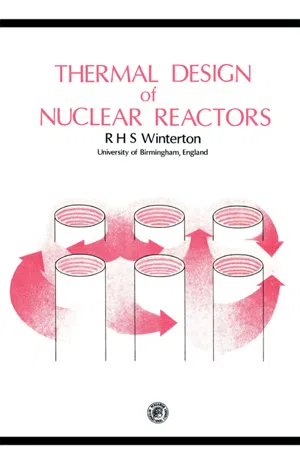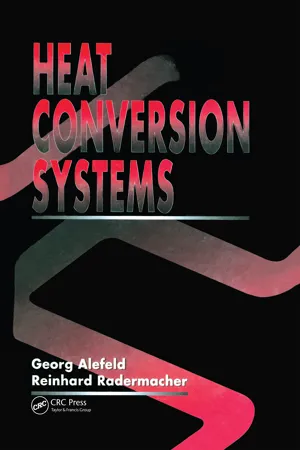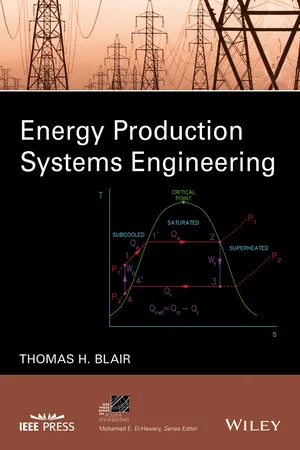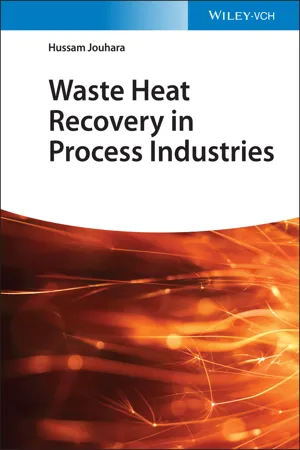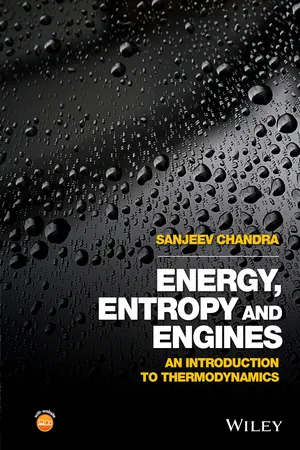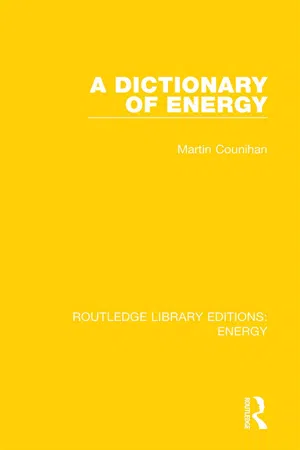Physics
Rankine Cycle
The Rankine cycle is a thermodynamic cycle used in power plants to convert heat into mechanical work. It involves four main processes: compression, heating, expansion, and cooling. Water or steam is typically used as the working fluid, and the cycle is commonly used in steam turbine power plants to generate electricity.
Written by Perlego with AI-assistance
Related key terms
10 Key excerpts on "Rankine Cycle"
- eBook - ePub
Nuclear Reactor Thermal Hydraulics
An Introduction to Nuclear Heat Transfer and Fluid Flow
- Robert E. Masterson(Author)
- 2019(Publication Date)
- CRC Press(Publisher)
The Rankine Cycle was first proposed by William Rankine in 1850. The Rankine Cycle is responsible for almost 90% of the electric power produced in the world today. (The rest is produced by hydroelectric dams, windmills, and gas turbines.) It is the primary thermal cycle that coal-powered power plants and nuclear power plants use. It is so important that entire books have been written about it. Because of its importance to the nuclear power industry, we will devote most of this chatter to explaining how it works. The only other thermodynamic cycle that is economically competitive with the Rankine Cycle is the Brayton thermal cycle. The Brayton cycle uses compressible gases such as carbon dioxide, hydrogen, or helium rather than water as the working fluid. In the Brayton cycle, the coolant does not change phase, and this is the primary feature that distinguishes the Rankine Cycle from the Brayton cycle. These gases are also compressed in certain phases of the cycle. The Rankine Cycle can be thought as a “poor man’s” Carnot cycle because, when an efficient turbine is used, the T–S diagram begins to resemble that of a Carnot heat engine (see Chapter 6). The Brayton cycle is used in the study of gas turbines, and it is the basis for the air-breathing jet engine and similar propulsion devices. It is named for American engineer George Brayton, who first perfected it in the 1800s, although it was originally proposed and patented by an Englishman John Barber in 1791. The Brayton cycle is the basis of the gas-cooled reactor, and specifically the high-temperature gas reactor (HTGR), which is the commercial implementation of gas reactors in the United States. We will discuss the Brayton thermal cycle in Section 9.23. FIGURE 9.2 The inventors of the two most common thermal cycles used in the world today: William Rankine (on the left) and George Brayton (on the right) - eBook - ePub
Thermal Power Plant
Design and Operation
- Dipak Sarkar(Author)
- 2015(Publication Date)
- Elsevier(Publisher)
Thermodynamically, all three cycles, i.e., Carnot, Stirling, and Ericsson cycles are identical in nature, since all of them work between constant temperature at heat source and constant temperature at heat sink. All are theoretically capable of attaining identical efficiency, working between similar hot and cold end temperatures if there are no losses. However, none of these cycles finds practical application in commercial engines.1.6 Rankine Cycle
In a steam power plant supply and rejection of heat is more easily realized at constant pressure than at constant temperature. It was William John Macquorn Rankine , after whom the Rankine Cycle is named, who first calculated the maximum possible work that could be developed by an engine using dry saturated steam between the pressure limits of the boiler and condenser. The simplest steam cycle using dry saturated steam as the working fluid has the following basic components (Figure 1.8 ):a. Steam Generator/Boiler b. Steam Turbine c. Condenser d. Boiler Feed PumpThe Rankine Cycle is an ideal thermodynamic cycle involving the following processes:Figure 1.8 Simplest steam cycle.i. Steam generation in boiler at constant pressure ii. Isentropic expansion in steam turbine iii. Condensation in condenser at constant pressure iv. Pressurizing condensate to boiler pressure by isentropic compressionFigure 1.9 - eBook - ePub
- Andrè Garcia McDonald, Hugh Magande(Authors)
- 2012(Publication Date)
- Wiley(Publisher)
Rankine Cycle with pressurized, superheated steam entering a steam turbine and liquid water leaving a condenser.6.1.2 Vapor Power Cycles—Ideal Carnot CycleThe Carnot cycle is an ideal reversible cycle that can operate between two constant temperature reservoirs. It is the most efficient power cycle, lacking any practical counterpart, and is used as a comparison for other power-generating cycles. A schematic of the ideal Carnot cycle is shown in Figure 6.1 .The following points should be noted regarding this cycle:Figure 6.1 Ideal Carnot cycle6.1.3 Vapor Power Cycles—Ideal Rankine Cycle for Steam Power Plants(i) Process 1-2 is reversible and isothermal (T 1 = T 2 ). Liquid working fluid is converted to vapor in the boiler—a phase change occurs.(ii) Process 2-3 is reversible and adiabatic. There is no heat transfer (adiabatic), no changes in entropy (isentropic), and no losses (no irreversibilities). The vapor is expanded isentropically (see the T-s curve in Figure 6.1 ) in the turbine to produce useful work to drive the pump shaft and electrical generator.(iii) Process 3-4 is reversible and isothermal (T 3 = T 4 ). The expanded vapor is condensed to liquid in the condenser—a phase change occurs.(iv) Process 4-1 is reversible and adiabatic. The liquid working fluid is pressurized isentropically in a pump. There is no heat transfer (adiabatic), no changes in entropy (isentropic), and no losses (no irreversibilities).The ideal Rankine Cycle for steam power plants is similar to the Carnot cycle, and includes at least a steam turbine, a condenser, a pump, and a steam boiler or steam generator. Figure 6.2 shows a schematic of the ideal Rankine Cycle.Figure 6.2 Ideal Rankine CycleIn the Rankine Cycle for steam power plants, the condenser may be a large shell-and-tube heat exchanger supplied with cooling water to permit steam condensation. As shown in Figure 6.2 , steam condensation terminates at the saturated liquid state (point 4 on the saturation curve), which is different from the Carnot cycle (see Figure 6.1 ). The steam generator (boiler) may include a burner in which fuel is combusted to provide the heat needed for steam generation. A simple liquid pump, with reduced pump power requirements, can be used. For smaller pumps, a dedicated motor could be used to drive them (motor-driven pump); for larger pumps, an auxiliary steam turbine could be used to drive them (turbine-driven pump). It will be shown later through second-law analysis that losses in the boiler are high (see the T-s diagram of Figure 6.2 - eBook - ePub
- R. H. S. Winterton(Author)
- 2014(Publication Date)
- Pergamon(Publisher)
Fig. 9.3 The basic Rankine Cycle.Fig. 9.4 The points of the Rankine Cycle superimposed on the layout of the plant.Since liquids are almost incompressible the increase in temperature on passing through the pump is in fact much smaller than indicated in the figure. Drawn to scale it would not appear at all, and process 1-2 would follow the saturation line. In the ideal cycle the expansion through the turbine is assumed to be isentropic (the prime indicates that 4′ represents the end point of the ideal expansion, not the actual condition of the steam at point 4).Changes of potential and kinetic energy of the water/steam around the circuit are small and normally neglected, so the steady-flow energy equation reduces toand since in the turbine no heat is exchanged and in the boiler no work is done we have the simple relations: work out of the turbine equals the decrease in enthalpy of the steam; and, as before, heat supplied in the boiler equals the increase in enthalpy of the water/steam. The ratio of these two quantities is the thermal efficiency of the steam cycle. A high thermal efficiency is important because it means that a given electrical power output can be met with a smaller and cheaper nuclear plant.In practice, of course, there is some increase in entropy as the steam expands through the turbine, and the simplest way to allow for this is to use an experimentally determined isentropic efficiency :Values of the isentropic efficiency are typically around 0.85.In view of the importance of enthalpy values in steam cycle calculations it is useful to have a chart that gives enthalpy values directly. The enthalpy-entropy diagram (or Mollier chart) for unit mass of water/steam is shown in Fig. 9.5 . The shape of this chart can be roughly explained as a distorted version of the temperature-entropy graph. In the region where there is a mixture of water and steam the constant pressure lines rise steeply, since both enthalpy and entropy increase as the mixture changes from saturated water to saturated steam. The enthalpy increase in going from saturated water to a mixture with a dryness fraction x is xh lv , and the entropy increase is xh lv /T sat , since entropy = . Consequently the constant pressure lines in the wet steam region can be divided into equal intervals of dryness fraction x - eBook - ePub
- Georg Alefeld, Reinhard Radermacher(Authors)
- 2023(Publication Date)
- CRC Press(Publisher)
The most commonly employed thermodynamic cycle in heat conversion systems is the Rankine Cycle or, more generally, the Rankine Sorption Cycle. This class of cycles is distinguished from gas cycles by the two-phase changes which occur during the course of the cycle. For heat engines, the pressure increase is accomplished in the condensed phase. The expansion occurs in the gas phase. The Rankine Cycle has the advantage that the net output of work is essentially identical to the expansion work. This is not the case in gas cycles. For vapor-compression heat pumps, the expansion occurs in the liquid phase. Since the amount of expansion work which could be recovered is small compared to the compression work, it is possible to replace the expansion turbine by a throttle. The heat-conversion processes in absorption heat pumps are also accomplished in total or in part by Rankine Sorption Cycles.3.1 The Rankine Cycle with Input and Output of Work
Figure 3.1 shows in a three dimensional P,ln(v),T representation the well-known Rankine Cycle, 1-2-3-4-5-6, as it is employed in steam power plants and Rankine Cycles working with organic fluids. State points 6-5-4—3-7 denote the Rankine Cycle as used in vapor-compression heat pumps. The arrows within the diagram have the following meaning: If an arrow is pointing towards a line which represents a process line, then heat is supplied to the working fluid, and vice versa. In contrast to the gas cycles of Figure 3.1 (Stirling Cycle, Joule Brayton Cycle, and Carnot Cycle), the Rankine Cycle shows two-phase changes. The necessary increase in pressure occurs in the condensed phase of the working fluid, and only a minimum amount of work is required. Therefore, the work gained by the expansion 5-6 represents approximately the net work produced. For gas cycles, the net work is the difference between two large numbers and is strongly dependent on the efficiencies for the expansion and compression machines. When the Rankine Cycle is used for heat pumping and when temperatures and pressures are far below the critical point, the expansion 3-2-1 can be accomplished by a simple throttle (3-7) causing relatively small losses of work. Figures 3.2 (a-g) and 3.3 (a-g) show projections of the Rankine Cycles with input and output of work in various diagrams. The representation ln(P) vs. -1/T, which is a projection parallel to the ln(v) axis of Figure 3.1 , is included here for comparison because this diagram is later referred to extensively. Figures 3.2h and 3.3h show the essential components of the respective cycles. The small expander in Figure 3.3h is usually replaced by a throttle device. The T, s diagram in Figure 3.2d is traditionally used to design steam-based power generation cycles. Figure 3.4 shows the diagram in a larger scale for water. The ln(P),h diagram for Figure 3.2e is traditionally used for the design of vapor-compression heat pumps. Figures 2.9 and 2.10 (Chapter Two ) show examples for ammonia and refrigerant R22. Usually, the diagrams of Figures 3.2d - eBook - ePub
- Thomas Howard Blair(Author)
- 2016(Publication Date)
- Wiley-IEEE Press(Publisher)
equation (2.23) .(2.23)In the Carnot cycle shown in Figure 2.4 , the theoretical maximum efficiency of the steam cycle can be described using temperatures (in units of Rankin) and is given by the equation (2.24) . This is because the Carnot cycle has the entire process occurring in the saturated steam region where temperature does not change with the change in enthalpy.(2.24)where- Tout = the absolute temperature for heat rejection (°R)
- Tin = the absolute temperature for heat addition (°R)
As we will learn later in Chapter 9 covering pumps, pumps are designed to pump fluids only and not steam. Pumps designed to pump water can quickly fail due to a phenomenon known as cavitation when steam forms in the pump. This is discussed in more detail in Chapter 9 .Since pumps are not designed to pump steam, the system must be designed such that the compression function is performed in the subcooled region where evaporation in the pump suction cannot occur. Therefore the Carnot cycle is not representative of the actual thermodynamic cycle of a plant but was a good place to start to understand the basic thermodynamic cycle.The Rankine Cycle, as shown in Figure 2.5 , describes the more realistic thermodynamic cycle. There are several differences between the ideal (Carnot) and actual (Rankine) thermodynamic cycles that we will discuss below.Figure 2.5 Basic Rankine Cycle showing operation in subcooled region for pumps. .Source: Reproduced with permission of U.S. Department of EnergyIn the basic Rankine Cycle, energy is transferred in the form of heat during the evaporation process and the condensation process. Energy is transferred in the form of work during the compression process and the expansion process. - eBook - ePub
- Irving Granet, Jorge Alvarado, Maurice Bluestein(Authors)
- 2020(Publication Date)
- CRC Press(Publisher)
8 Vapor Power Cycles and Alternative Power SystemsLearning Goals
After reading and studying the material in this chapter, you should be able to- 1. Understand the definition of the term cycle , and differentiate between gas and vapor cycles.
- 2. Recall that our conclusions regarding the Carnot cycle were independent of the working fluid used in the cycle.
- 3. Sketch and analyze the elements of the simple Rankine Cycle.
- 4. Conclude that for the same pressures, the efficiency of the Rankine Cycle is less than that of a Carnot cycle.
- 5. Define the type efficiency as the ratio of the ideal thermal efficiency of a given cycle divided by the efficiency of a Carnot cycle operating between the same maximum and minimum temperature limits.
- 6. Sketch the simple reheat cycle elements and T–s and h–s diagrams for this cycle.
- 7. Conclude that reheat does not greatly increase the efficiency of the Rankine Cycle but does decrease the moisture content of the steam in the later stages of the turbine.
- 8. Understand that regeneration is a method of heating the feedwater with steam that has already done some work and that in the limit, regenerative cycle approaches the efficiency of the Carnot cycle operating between the same temperature limits.
- 9. Apply regeneration to the Rankine Cycle, sketch the T–s diagram, and show how regeneration improves the Rankine Cycle efficiency.
- 10. Qualitatively understand the construction and operation of the major pieces of equipment used in commercial steam-generating plants.
- 11. Understand other methods that have been proposed and/or constructed for the production of power, including direct energy devices.
- 12. Understand the use of cogeneration as a combination of power production and process or space use.
8.1 Introduction
A cycle has been defined as a series of thermodynamic processes during which the working fluid can be made to undergo changes involving energy transitions and subsequently is returned to its original state. The objective of any practical cycle is to convert energy from one form to another, more useful form. For instance, the energy bound in a fossil fuel is released by the chemical process of combustion and, by undergoing appropriate thermodynamic processes, is made to yield useful work at the shaft of an engine. Similarly, the energy of the nuclear-fission process is made to yield useful work that ultimately appears as electrical energy. - eBook - ePub
- Hussam Jouhara(Author)
- 2021(Publication Date)
- Wiley-VCH(Publisher)
Figure 1.31 is a cogeneration cycle used for hot temperature applications, where instead of extracting steam from the turbine at an intermediate pressure, the steam is extracted just after the boiler. Hence, this steam is hotter (because its pressure is higher) and for that reason the configuration is suitable for hot temperature applications. It is also controllable by means of an expansion valve positioned just before the heat exchanger which controls the pressure (and therefore the temperature) inside the exchanger allowing the system to adapt to different heating demands.1.2.5 Other Configurations of the Rankine Cycle
So far, only the classical Rankine Cycle and its possible improvements have been presented. This section now describes other thermodynamic cycles, derived from the Rankine Cycle, which also use steam as a working fluid.1.2.5.1 Supercritical Rankine Cycles
As we have noted previously, increasing the HP of the system results in a more work given to the turbine. However, because of the vapour dome, it also results in a lower steam quality at the end of the expansion phase. The supercritical Rankine Cycle (SRC ) bypasses this issue, because the working fluid is brought to such a condition that its pressure is above its critical pressure – a condition where the fluid is in a supercritical state and where there is now no longer a link between its vapour pressure and its temperature.Schematic of a cogeneration Rankine Cycle for hot temperature applications.Figure 1.31Advances in metallurgy and manufacturing techniques have made this possible, to the point where we can realistically increase the HP to a pressure greater than the critical pressure (for water) of 22.064 MPa (220.64 bar).Hence, in an SRC, as the name implies, the fluid is in a supercritical state, i.e. it is behaving as a liquid and a gas at the same time. Working as a SRC increases the area of the cycle on the T–s diagram (see Figure 1.32 - eBook - ePub
Energy, Entropy and Engines
An Introduction to Thermodynamics
- Sanjeev Chandra(Author)
- 2016(Publication Date)
- Wiley(Publisher)
9 Vapour Power and Refrigeration CyclesIn this chapter you will:
- Study the Rankine Cycle used by vapour–power heat engines.
- Analyse different methods to improve the performance of the Rankine Cycle, such as superheat, reheat and regeneration.
- Learn how to build a refrigerator or heat pump using a reverse Rankine Cycle.
9.1 Rankine Cycle
The Carnot cycle, we have demonstrated, produces the most efficient heat engine possible; it seems reasonable to expect that steam power plants all around the world would be operating using this cycle. Granted that real turbines are not perfectly reversible and adiabatic, but it should still be possible to reasonably approximate the four processes that make up the Carnot cycle. However, this is not the case since the Carnot cycle, though theoretically ideal, proves impractical to implement in reality.One major difficulty in building a two-phase Carnot engine is that it is difficult to compress a liquid–vapour mixture. In Figure 8.6 , which showed a Carnot cycle on a T-s diagram, a two-phase mixture entered a pump at state 1, was compressed to a higher pressure and temperature, and left as saturated liquid at state 2. In practice it is difficult to pump a two-phase mixture, for two reasons. First, recall from Chapter 4 that the work done by a pump isThe work required for driving the pump increases with the specific volume of the fluid. If we introduce vapour into a liquid the specific volume of the mixture increases significantly, and with it the work required by the pump. If there are vapour bubbles in the liquid they have to be compressed by the pump, which requires additional work. The second problem is that a two-phase mixture creates a fluctuating load in a pump or compressor as vapour bubbles and liquid slugs impinge alternately on the impeller blades, eroding surfaces and damaging the machinery. - eBook - ePub
- Martin Counihan(Author)
- 2019(Publication Date)
- Routledge(Publisher)
thermal pollution The discharge of waste heat to the environment. It is of most concern when large power stations release low-grade heat in water which can upset the ecologies of the rivers, estuaries or coastal waters where it is discharged.thermal reactor A kind of nuclear reactor, which has thermal neutrons within its core and produces energy mainly by the stimulated fission of 235 U. Practically all commercial nuclear reactors are thermal reactors, and are distinguished from ‘fast’ reactors which use higher energy neutrons to breed plutonium.thermie A million calories. See ‘Units’, Table B .thermocouple An instrument for measuring temperature through the Seebeck effect, i.e. using the voltage which can appear between two junctions in an electrical circuit when they are at different temperatures. See alsothermoelectricity.thermodynamic cycles In the analysis of the various kinds of heat engines it is often useful to consider idealised working cycles in which each step is perfectly isentropic, isobaric, isothermal or iso-volumetric; this simply means that during each part of the cycle some parameter (entropy, pressure, temperature or volume) is kept constant. This leads to a family of thermodynamic cycles, and in particular the Brayton, Carnot, Diesel, Otto and Rankine Cycles. Each cycle has four stages, as shown in Table 16 . The main difference between the Rankine Cycle and the Brayton cycle is that the former is the idealised steam cycle and therefore there are phase changes (vaporisation and condensation) of the fluid during the cycle.Table 16 Thermodynamic cyclesName Stage of cycle Stage Compression Heating Expansion Exhaust Brayton Isentropic Isobaric Isentropic Isobaric Carnot Isentropic Isothermal Isentropic Isothermal Diesel Isentropic Isobaric Isentropic Isovol. Otto Isentropic Isovol. Isentropic Isovol. Rankine Isentropic Isobaric Isentropic Isobaric thermodynamics
Index pages curate the most relevant extracts from our library of academic textbooks. They’ve been created using an in-house natural language model (NLM), each adding context and meaning to key research topics.
